|
|
Product Overview
• Cisco Global Systems for Mobile Communications (GSM) Radio Access Network (RAN) Optimization solution (Figure 1)
• Cisco IP RAN solution
• Cisco IP Transfer Point (ITP) networks
• Cisco Mobile Internet Infrastructure (MI2).
Figure 1. Cisco Mobile Wireless Transport Manager and RAN Optimization Overview
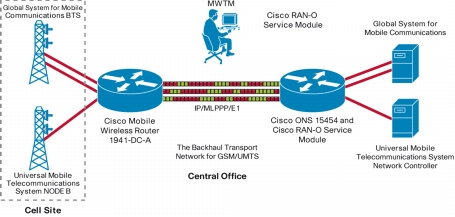
Features
Basic Capabilities
• Discovers the entire Cisco ITP network and displays the ITP devices, neighboring Signaling System 7 (SS7) equipment, and linksets in tables and in a network topology drawing that users can customize. Users can create custom views and subordinate views for combining similar devices together, where each subordinate view displays the state of the contained devices.
• Locates the entire Cisco IP RAN and RAN Optimization network and displays each network element, neighboring equipment, and physical/logical connectivity in a network topology drawing that users can customize (RAN Optimization only). Users can create custom views and subordinate views for grouping similar devices together, where each subordinate view displayes the state of the contained devices Discovers and monitors the Cisco Mobile Internet infrastructure next-generation network, including troubleshooting and real-time statistics viewing.
• Provides an easy-to-use GUI client (Figure 2) and robust server processes that can be managed by a powerful command-line interface (CLI).
• Allows printing windows to a file or PostScript printer, as well as saving the topology map to a JPEG file.
• Provides integrated, online, context-sensitive help that can be customized to suit specific operational needs or languages.
• Supports Windows and Solaris clients (based on client/server architecture) and Solaris and Linux servers and provides data access through a web browser.
• Allows clients to connect to a server through the IP network; clients work across a VPN connection through a firewall that supports port forwarding or Network Address Translation (NAT) and through a Secure Sockets Layer (SSL) connection.1
Figure 2. Cisco Mobile Wireless Transport Manager Overview for the Cisco ITP Solution
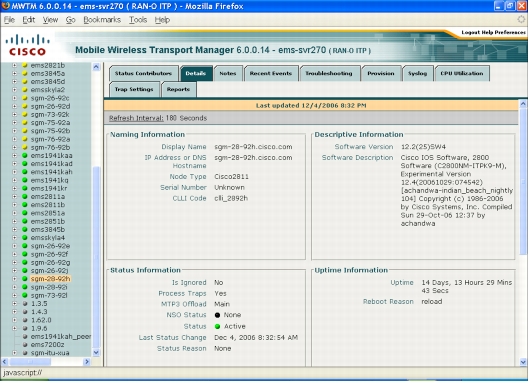
Event Monitoring
• Displays a real-time event list that supports acknowledgement, annotation, customized filtering, and field viewing that conform to ITU-T X.733 standards (Figure 3).
• Receives native traps from hardware devices in the Cisco IP RAN, RAN Optimization, Cisco ITP, and Mobile Internet solutions and uses Simple Network Management Protocol (SNMP) polling to identify the status of each managed Cisco Mobile Internet and RAN device and ITP platform. Cisco MWTM uses easy-to-recognize, color-coded icons and an X.733-based alarm format to report the status.
• Provides web-based status monitoring, alarm viewing, sorting, filtering, archiving, online documentation, and client download.
• Provides external script execution on the server and sound-based notifications on the client; both are customizable and triggered by events or alarms.
Figure 3. Cisco Mobile Wireless Transport Manager Event Browser for the Cisco ITP Solution
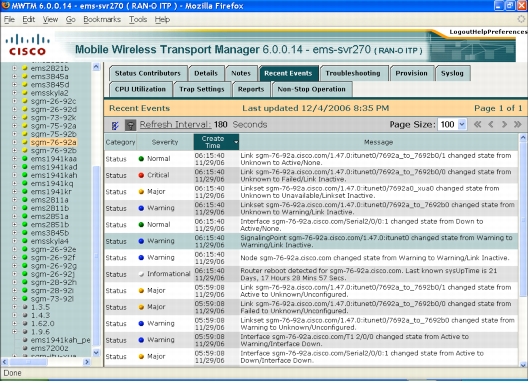
Wizard-Based Provisioning
• Provides configuration support for Cisco Content Services Gateway and Cisco GPRS GGSN Service Node.
• Assists in provisioning destination point code (DPC) route tables, global title translation (GTT) tables, multilayer routing (MLR) address tables, links, and linksets by providing GUI-based editing (Figure 4); reduces errors by checking syntax and semantics before deploying the tables to the Cisco ITP device.
• Assists in provisioning and provides revision management and archiving of DPC route, GTT, and MLR address tables; can redeploy a known-good configuration in the event of a misconfiguration; stores time of change, user ID, and comments for each change.
• Supports configuration of Cisco IP RAN devices (Cisco MWR-1941, Cisco 3825, and Cisco 7600) with strong semantic and syntactic checks for attributes such as Pseudowire cross-connects, ATM cell switching, and controller configuration.
Figure 4. Cisco MWTM Linkset Configuration for Cisco ITP Solution
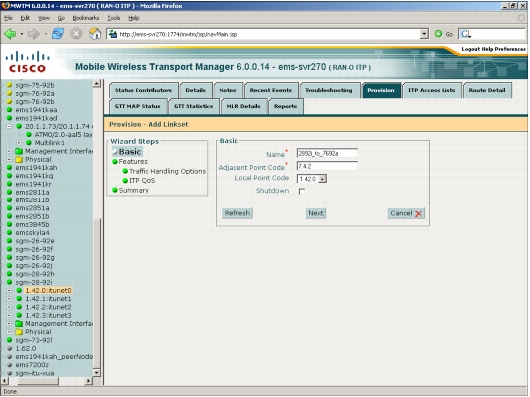
Performance Reporting
• Provides extensive web-based accounting and network statistics reports
– Cisco IP RAN and RAN Optimization devices: Network utilization (Figure 5) and detailed interface-level statistics such as PWE3 statistics
– Cisco ITP devices: Network efficiency and detailed interface-level statistics as well as Q.752-based statistics reports, point code inventory reports, including MTP3, GTT, M3UA/SUA, MSU, and multilayer routing reports
– Cisco Mobile Internet devices: Access point names for Cisco GGSN and attributes such as maps and billing services for Cisco CSG and Cisco Home Agent statistics
• Displays real-time data rate and usage line graphs
• Supports options to configure collection intervals, record aging, and export statistics using comma-separated value (CSV) format files
Figure 5. Cisco Mobile Wireless Transport Manager Historical Performance Report for the Cisco RAN Optimization Solution
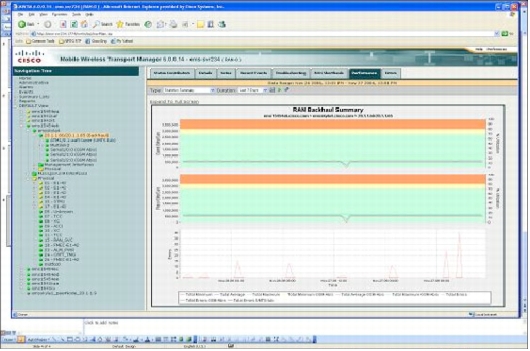
Troubleshooting
• Provides customizable troubleshooting tools that aid in reducing the total time to resolution of network/device problems
• Cisco Mobile Internet: Provides the ability to search for a subscriber by NAI for Cisco Home Agent devices, or by MSISDN for Cisco GGSN devices
• Provides integrated, online, context-sensitive help
Third-Party OSS Product Integration
• Receives SNMP traps and generates Cisco MWTM-specific traps for forwarding to external SNMP-based network management applications such as HP OpenView or IBM Tivoli Netcool
• Stores statistics in CSV format files for extracting performance and key performance indicator (KPI) metrics information
• Northbound Cisco ITP, Mobile Internet, IP RAN, and RAN Optimization Events Extensible Markup Language (XML)/Simple Object Access Protocol (SOAP) APIs that allow third-party OSSs to programmatically manage MWTM events by:
– Retrieving a list of all events or a filtered list of events (based on time, event ID, severity, category, message text)
– Clearing the event alarm
– Changing event severity
– Acknowledging an event
– Attaching a text note to an event
• Northbound Cisco ITP, Mobile Internet, IP RAN, and RAN Optimization Inventory XML/SOAP APIs that allow third-party OSSs to programmatically access MWTM inventory by:
– Retrieving all inventory objects
– Retrieving a specific inventory object
– Walking the MWTM inventory tree
– Attaching a text note to an inventory object
• Northbound provisioning XML/SOAP APIs that allow third-party OSSs to programmatically manage provisioning by customizing MWTM templates when necessary and to configure:
– Cisco ITP devices
– Cisco Mobile Internet devices: Cisco CSG and Cisco GGSN
– Cisco IP RAN devices
Security
• Multiple user-authentication methods supported: Pluggable Authentication Modules (PAM), OS-based, and standalone
• Password enforcement policies: Aging, minimum length, and lockouts
• Audit trails and logging capabilities
• Optional SSL-based encryption between client and server support
• Optional Secure Shell (SSH) Protocol-based encryption between server and network elements
Carrier-Class Features
• Scalability: Cisco MWTM supports large networks and has been verified to work with a large-scale network.
• Security: Cisco MWTM supports user authentication, multiple levels of user access, password-protected web pages, activity logging for audit trails, and an optional package for encrypting all client/server communications data.
• Redundancy: Multiple Cisco MWTM servers can monitor the network simultaneously, providing data redundancy. Clients have server failure recognition and automatic failover capabilities.
• Availability: Cisco MWTM clients will automatically switch to a backup server when the primary server is not available (in network problems or hardware failures, for example).
Interoperability
Product Specifications
Table 1. Cisco Mobile Wireless Transport Manager Device Support
System Requirements
Ordering Information
Service and Support
For More Information
cs-mwtm@cisco.com.